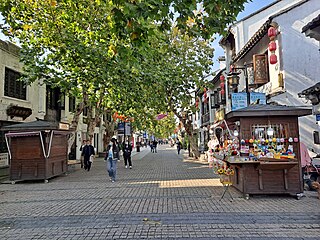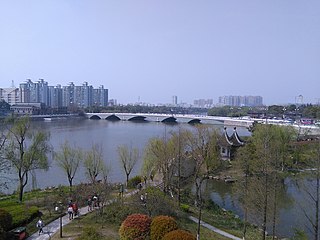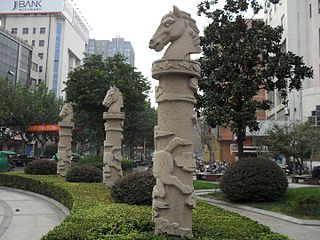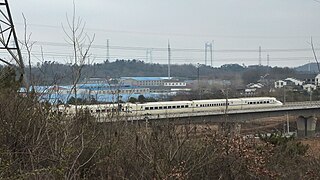
Nanjing is the capital of Jiangsu province in eastern China. It is a sub-provincial city, and a megacity. The city has 11 districts, an administrative area of 6,600 km2 (2,500 sq mi), and a population of 9,423,400 as of 2021. Situated in the Yangtze River Delta region, Nanjing has a prominent place in Chinese history and culture, having served as the capital of various Chinese dynasties, kingdoms and republican governments dating from the 3rd century to 1949, and has thus long been a major center of culture, education, research, politics, economy, transport networks and tourism, being the home to one of the world's largest inland ports. The city is also one of the fifteen sub-provincial cities in the People's Republic of China's administrative structure, enjoying jurisdictional and economic autonomy only slightly less than that of a province. Nanjing has been ranked seventh in the evaluation of "Cities with Strongest Comprehensive Strength" issued by the National Statistics Bureau, and second in the evaluation of cities with most sustainable development potential in the Yangtze River Delta. It has also been awarded the title of 2008 Habitat Scroll of Honor of China, Special UN Habitat Scroll of Honor Award and National Civilized City. Nanjing is also considered a Beta city classification, together with Chongqing, Hangzhou and Tianjin by the Globalization and World Cities Research Network, and ranked as one of the world's top 100 cities in the Global Financial Centres Index.

Jiangsu is an eastern coastal province of the People's Republic of China. It is one of the leading provinces in finance, education, technology, and tourism, with its capital in Nanjing. Jiangsu is the third smallest, but the fifth most populous and the most densely populated of the 23 provinces of the People's Republic of China. Jiangsu has the highest GDP per capita and second-highest GDP of Chinese provinces, after Guangdong. Jiangsu borders Shandong in the north, Anhui to the west, and Zhejiang and Shanghai to the south. Jiangsu has a coastline of over 1,000 kilometers (620 mi) along the Yellow Sea, and the Yangtze River passes through the southern part of the province.

Wuxi is a city in southern Jiangsu province, eastern China. As of the 2020 census, the city had a total population of 7,462,135 inhabitants.

Liyang is a county-level city under the administration of Changzhou in the Jiangsu province of the People's Republic of China. In 2011, it had a population of about 781,500. It borders the prefecture-level divisions of Wuxi to the east, Xuancheng (Anhui) to the south, and Nanjing to the west.

Yangzhou is a prefecture-level city in central Jiangsu Province, East China. Sitting on the north bank of the Yangtze, it borders the provincial capital Nanjing to the southwest, Huai'an to the north, Yancheng to the northeast, Taizhou to the east, and Zhenjiang across the river to the south. Its population was 4,559,797 at the 2020 census and its urban area is home to 2,635,435 inhabitants, including three urban districts, currently in the agglomeration.

Nantong is a prefecture-level city in southeastern Jiangsu province, China. Located on the northern bank of the Yangtze River, near the river mouth. Nantong is a vital river port bordering Yancheng to the north; Taizhou to the west; Suzhou, Wuxi and Shanghai to the south across the river; and the East China Sea to the east. Its population was 7,726,635 as of the 2020 census, 3,766,534 of whom lived in the built-up area made up of three urban districts.

Jiangnan is a geographic area in China referring to lands immediately to the south of the lower reaches of the Yangtze River, including the southern part of its delta. The region encompasses the city of Shanghai, the southern part of Jiangsu Province, the southeastern part of Anhui Province, the northern part of Jiangxi Province and the northern part of Zhejiang Province. The most important cities in the area include Anqing, Changzhou, Hangzhou, Nanjing, Ningbo, Shaoxing, Suzhou, Wuxi, Wenzhou, Yangzhou and Zhenjiang.

The Yangtze Delta or Yangtze River Delta, previously known as the Shanghai Economic Zone, is a triangle-shaped megalopolis generally comprising the Wu-speaking areas of Shanghai, southern Jiangsu, northern Zhejiang, southern Anhui. The area lies in the heart of the Jiangnan region, where the Yangtze drains into the East China Sea. Historically the fertile delta fed much of China’s population, and cities and commerce flourished. Today, it is one of China’s most important metropolitan area and is home to China’s financial center, tourist destination and hub for manufacture ranging from textile to car-making. In 2021, the Yangtze Delta had a GDP of approximately US$4.3 trillion, about the same size as Japan.

Changzhou is a prefecture-level city in southern Jiangsu, China. It was previously known as Yanling, Lanling, and Jinling. Located on the southern bank of the Yangtze River, Changzhou borders the provincial capital of Nanjing to the west, Zhenjiang to the northwest, Wuxi to the east, and the province of Zhejiang to the south. The population of the Changzhou Municipality was 5,278,121 at the 2020 census. The city is the birthplace of Zhou Youguang who created the pinyin romanization system.

Taizhou is a city in Jiangsu in eastern China. Situated on the north bank of the Yangtze River, it borders Nantong to the east, Yancheng to the north and Yangzhou to the west.

Jingjiang is a county-level city under the administration of Taizhou, Jiangsu province, China. It is located on the northern (left) bank of the Yangtze River, and is the southernmost part of Taizhou City, bordering Nantong to the northeast, Suzhou to the southeast, Wuxi to the south, Changzhou to the southwest, and Zhenjiang to the west. The area of Jingjiang is 655.6 square kilometres and the population was 684,360 at the 2010 census.
Changzhou Senior High School was founded on November 15, 1907. It is located in downtown of Changzhou, itself a city with 2500 years of history, and adjacent to the picturesque local attractions Hongmei Park and Tianning Temple. In a 2016 ranking of Chinese high schools which sent students to American universities, the high school ranked number 49th.

Zhenjiang railway station is a railway station of Beijing–Shanghai railway and Shanghai–Nanjing intercity railway. The station is located in Zhenjiang, Jiangsu, China.

The Shanghai–Nanjing intercity railway or Huning intercity railway is a 301-kilometer (187 mi)-long high-speed rail line between Shanghai and Nanjing, the capital of Jiangsu province. Hù and Níng are shorthand Chinese names for Shanghai and Nanjing, respectively. The Huning intercity high-speed railway largely follows the route of the preexisting Nanjing-Shanghai section of the conventional Beijing–Shanghai railway and the Beijing–Shanghai high-speed railway. Construction of this high-speed railway began in July 2008. The line went into test operations in early April 2010, and opened for full service on July 1, 2010. The line has a design speed of 350 km/h (217 mph). The journey time between the two cities has been shortened from 120 minutes to 73 minutes on nonstop trains. According to the arrangements of related departments, 120 pairs of trains are operating on the line, and the time interval between services is 5 minutes at the shortest.

The Suzhou High School of Jiangsu Province (江苏省苏州中学) is a public high school in Suzhou, Jiangsu, China.
Railways in Jiangsu, China have existed in the province since the early 20th century. More than 40 large and medium-sized cities in Jiangsu are connected by rail; Nanjing and Xuzhou are transportation centers. Two national rail lines—Longhai Railway and Jinghu Railway —cross the province. A rail link among eight cities in the province is planned. Train travel is popular in China; it is fast, more widely available than automobile travel and more economical than travel by air.

The Shanghai–Chengdu Expressway, designated as G42 and commonly referred to as the Hurong Expressway is an east–west bound expressway that connects the eastern metropolis of Shanghai to Chengdu, the capital city of Sichuan. The expressway passes through six provinces and serves major cities such as Suzhou, Wuxi, Changzhou, Nanjing, Hefei, Wuhan, and Yichang. The eastern terminus of G42 is at the Wuning Road Interchange of Shanghai Middle Ring Road. At its western terminus, the expressway intersects the East 3rd Ring Road and connects East Erxianqiao Road in Chenghua District, Chengdu. The expressway spans 1,960 km (1,220 mi) in length.
The Port of Zhenjiang is a natural inland river port located on Zhengjiang Prefectural Level city, Jiangsu, People's Republic of China. It is one of the succession of large shipping hubs lining the estuary and lower course of the Yangtze. The Port had a throughput of 140,984,000 tonnes of total cargo in 2013, an increase of 4.7%

Jiangnan, formerly romanized as Kiangnan, was a historical province of the early Qing dynasty of China. Its capital was Jiangning, from which it is sometimes known as Nanjing or Nanking Province. Established in 1645 during the Qing conquest of Ming, it administered the area of the earlier Ming province of Nanzhili, reaching from north of the Huai River—at the time the course of the Yellow River—to south of the Yangtze River in East China. Its territory was later divided into the separate provinces of Jiangsu and Anhui during the reign of the Qianlong Emperor (1736–1795), although the exact timing is disputed. Under the Republic and People's Republic of China, an area of Jiangsu also became the provincial-level municipality of Shanghai.

Qingjiangpu District is one of four urban districts in the prefecture-level city of Huai'an in China's Jiangsu Province. It was established on 8 June 2016. The district has an area of 420 km2 (160 sq mi) with a population of 735,900 (2016). Qingjiangpu includes 12 subdistricts and 7 towns or townships under its jurisdiction. Its seat is in Chengnan Subdistrict (城南街道).

































